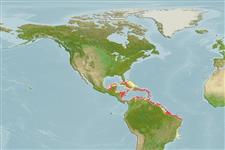>
Carangaria/misc (Various families in series Carangaria) >
Centropomidae (Snooks)
Etymology: Centropomus: Greek, kentron = sting + Greek, poma, -atos = cover, operculum (Ref. 45335).
More on author: Poey.
Environment: milieu / climate zone / rango de profundidad / distribution range
Ecología
marino; agua dulce; salobre bentopelágico; anfidromo (Ref. 51243); rango de profundidad ? - 22 m (Ref. 26912). Subtropical; 25°N - 23°S, 98°W - 34°W
Western Atlantic: southern Florida (USA), Greater and Lesser Antilles, and continental Caribbean coasts of Central and South America southward extending to Rio de Janeiro, Brazil.
Tamaño / Peso / Age
Madurez: Lm ? range ? - ? cm
Max length : 36.2 cm TL macho / no sexado; (Ref. 40637); common length : 25.0 cm TL macho / no sexado; (Ref. 5217); peso máximo publicado: 1.0 kg (Ref. 5217)
Espinas dorsales (total) : 8 - 9; Radios blandos dorsales (total) : 10; Espinas anales: 1 - 3; Radios blandos anales: 6. 2nd spine of anal fin greatly enlarged; body yellowish brown dorsally, silver laterally and ventrally; lateral line dusky; pectoral and pelvic fins yellow, other fins dusky (Ref. 13608).
Body shape (shape guide): fusiform / normal.
Inhabits coastal waters, estuaries and lagoons, penetrating into freshwater; usually prefers very low brackish water or freshwater. Found over soft bottoms (Ref. 5217). Feeds on small fishes (Engraulidae, Clupeidae, etc.) and crustaceans (mainly shrimps) (Ref. 35237).
Juveniles in mangrove areas and irrigation canals.
Fraser, T.H., 1978. Centropomidae. In W. Fischer (ed.) FAO species identification sheets for fishery purposes. West Atlantic (Fishing Area 31). FAO, Rome. Vol. 1-2. pag.var. (Ref. 3713)
IUCN Red List Status (Ref. 130435: Version 2025-1)
Threat to humans
Harmless
Human uses
Pesquerías: escaso valor comercial; pesca deportiva: si
Herramientas
Special reports
Download XML
Fuentes de Internet
Estimates based on models
Preferred temperature (Referencia
123201): 26.8 - 28.3, mean 27.5 °C (based on 517 cells).
Phylogenetic diversity index (Referencia
82804): PD
50 = 0.5002 [Uniqueness, from 0.5 = low to 2.0 = high].
Bayesian length-weight: a=0.00724 (0.00431 - 0.01217), b=3.09 (2.94 - 3.24), in cm total length, based on LWR estimates for this species & Genus-body shape (Ref.
93245).
Nivel trófico (Referencia
69278): 4.2 ±0.62 se; based on food items.
Resiliencia (Referencia
120179): Medio, población duplicada en un tiempo mínimo de 1.4-4.4 años (tm=3-4; Fec=80,000).
Fishing Vulnerability (Ref.
59153): Low to moderate vulnerability (26 of 100).
🛈
Nutrients (Ref.
124155): Calcium = 58.7 [33.6, 120.4] mg/100g; Iron = 0.742 [0.452, 1.292] mg/100g; Protein = 19.3 [17.0, 21.5] %; Omega3 = 0.39 [0.18, 0.89] g/100g; Selenium = 17.8 [9.1, 32.5] μg/100g; VitaminA = 26.9 [9.7, 79.2] μg/100g; Zinc = 0.949 [0.660, 1.368] mg/100g (wet weight);
